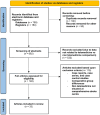Is telestroke more effective than conventional treatment for acute ischemic stroke? A systematic review and meta-analysis of patient outcomes and thrombolysis rates
- PMID: 37752674
- PMCID: PMC10903130
- DOI: 10.1177/17474930231206066
Is telestroke more effective than conventional treatment for acute ischemic stroke? A systematic review and meta-analysis of patient outcomes and thrombolysis rates
Abstract
Background: Telestroke systems operate through remote communication, providing distant stroke evaluation through expert healthcare providers. The aim of this study was to assess whether the implementation of a telestroke system influenced stroke treatment outcomes in acute ischemic stroke (AIS) patients compared with conventional in-person treatment.
Aims: The study group evaluated multiple studies from electronic databases, comparing telemedicine (TM) and non-telemedicine (NTM) AIS patients between 1999 and 2022. We aimed to evaluate baseline characteristics, critical treatment times, and clinical outcomes.
Summary of review: A total of 12,540 AIS patients were included in our study with 7936 (63.9%) thrombolyzed patients. Of the thrombolyzed patients, 4150 (51.7%) were treated with TM, while 3873 (48.3%) were not. The mean age of TM and NTM cohorts was 70.45 ± 4.68 and 70.42 ± 4.63, respectively (p > 0.05). Mean National Institute of Health Stroke Scale scores were comparable, with the TM group reporting a non-significantly higher mean (11.89 ± 3.29.6 vs. 11.13 ± 3.65, p > 0.05). No significant difference in outcomes was found for symptoms onset-to-intravenous tissue plasminogen activator (ivtPA) times (144.09 ± 18.87 vs. 147.18 ± 25.97, p = 0.632) and door-to-needle times (73.03 ± 20.04 vs. 65.91 ± 25.96, p = 0.321). Modified Rankin scale scores (0-2) were evaluated, and no significant difference was detected between cohorts (odds ratio (OR): 1.06, 95% confidence interval (CI): 0.89-1.29, p = 0.500). Outcomes did not indicate any significance between both cohorts for 90-day mortality (OR: 1.16, 95% CI: 0.94-1.43, p = 0.17) or symptomatic intracranial hemorrhage (OR: 0.99, 95% CI: 0.73-1.34, p = 0.93). Results between groups were also non-significant when analyzing the rate of thrombolysis with ivtPA (30.86%± 30.7 vs. 20.5%± 18.6, p = 0.372) and endovascular mechanical thrombectomy (11.8%± 11.7 vs. 18.7%± 18.9, p = 0.508).
Conclusion: The use of telestroke in the treatment of AIS patients is safe with minimal non-significant differences in long-term outcomes and rates of thrombolysis compared with face-to-face treatment. Further studies comparing the different methods of TM are needed to assess the efficacy of TM in stroke treatment.
Keywords: Telemedicine; acute ischemic stroke; ischemia; telestroke; thrombolysis.
Conflict of interest statement
Declaration of conflicting interestsThe author(s) declared no potential conflicts of interest with respect to the research, authorship, and/or publication of this article.
Figures
References
-
- Sood S, Mbarika V, Jugoo S, et al.. What is telemedicine? A collection of 104 peer-reviewed perspectives and theoretical underpinnings. Telemed J E Health 2007; 13: 573–590. - PubMed
Publication types
MeSH terms
Substances
LinkOut - more resources
Full Text Sources
Medical
Research Materials





